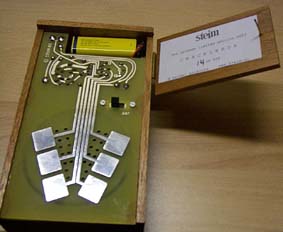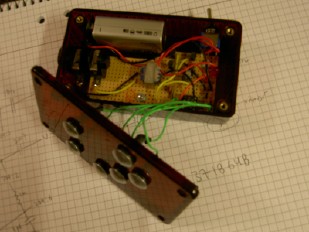DIY Kraakdoos / Crackle Box
randomvoltage.com
The Kraakdoos, or Crackle Box, was designed by Michel Waisvisz of STEIM in the seventies, the main concept being that the human body becomes a vital part of the electronics (or the other way around) while playing it. It is a touch and pressure sensitive device that squeeks and makes a lot of noise when played with. Listen to the sound examples provided at the end of this page.
I had been curious about the legendary Kraakdoos and wondered what this little noisemaker would sound like and how it was built. Eventually i found a schematic and i built one myself. Unfortunately that schematic is rather poorly drawn, so i took the liberty of redrawing it:
UPDATE I have realized that the schematic i originally published here had some errors in it due to misinterpretation of the original i used. While the old version sounds fun too, this is closer to the original. Luckily it is easily fixed if you want to try. Here is the old schematic with changes in green:
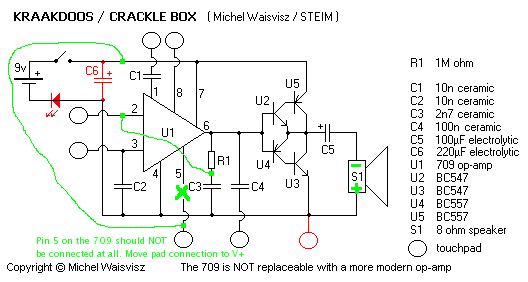
And here is what i believe to be the a correct schematic, properly drawn:
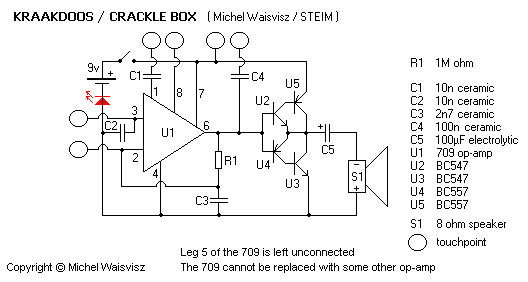
I have permission from Michel Waisvisz, the designer and copyright holder of the Kraakdoos, to publish this schematic for non-commercial, educational and personal use only.
As you can see in the updated schematic, leg 5 of the 709 is not connected. This is the way
the original kraakdoos is wired, but you are of course free to experiment further. The LED,
drawn in red in the schematic is not in the original design.
It actually modifies the sound slightly, but on the other hand it looks cool and it protects
the circuit from getting voltage the wrong way.
The "touchpoints" can be virtually anything conductive, this is where you make contact with
the circuit. See the pictures here for some examples.
The ceramic capacitors can be plastic if you prefer that.
The 709 op-amp seems to be hard to find in some countries. There are several manufacturers
of this chip, try searching for LM709, MC709 or uA709. According to
Wikipedia
the 709 op-amp can be found at Vintageplanet as MC1709CG.
Here is a 709 pin spec:
1: Input frequency compensation (A)
2: Inverting (-) input
3: Non inverting (+) input
4: V-
5: Output frequency compensation
6: Output
7: V+
8: Input frequency compensation (B)
Nowdays i have a real STEIM-built Kraakdoos, it sounds much like my home-built one,
but not exactly. There are some differences, most noticable is that the real one is much louder.
I think that they have improved the amplification in these new ones.
Here they are side by side, guess which one is STEIM made.
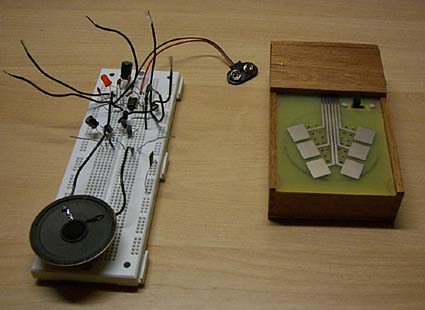
The components to build one of these are really cheap and it's quite simple to build, i put one together on a breadboard, as seen on the image above, in half an hour, less time than it took to redraw the schematic. But if you're not into building things at all, they can now be bought new from STEIM. They are now making these again in a limited edition. Look here too.
If you wish to build one yourself you will probably want a housing, here is an example of an alternative design.
The description on the original page of the schematic i have transcribed mentions that a 8ohm-10kohm transformer should be used in order to add line out. I found something similar and it works but it doesn't sound as good that way. Other ideas has been emailed to me. When/if we find a better way to add line out that works satisfactory i will publish it here.
S o u n d e x a m p l e s
These examples were made with my breadboard prototype Kraakdoos that had a one inch speaker laying
flat on the table. I used two microphones when recording it. I have not modified the sound in any
way, i just cut the recorded session into downloadable chunks.
~ Example 1 793k
~ Example 2 563k
~ Example 3 490k
~ Example 4 504k
~ Example 5 712k
This is what the STEIM kraakdoos looks like "under the hood", on the right is my homemade line out kraakdoos:
